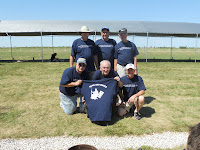Stopping power of a given bullet in a given cartridge in a given firearm is a complex topic, but one good metric is the simple physics formula for
muzzle energy, E=.5mv^2. For a modern standard-issue US military
.223/5.56mm round, somewhere in the ballpark of 1,282 ft·lbf (1,738 J) is typical. Back in WWII, our boys carried
.30-06 Springfield rounds with
over double that energy, 2,820 ft·lbf (3,820 J). A modern
.308/7.62x51 round used by snipers and some infantry semi-auto rifles packs roughly 2,619 ft·lbf (3,551 J). By comparison,
Dirty Harry's .44 Magnum handgun packed around 1,200 ft·lbf (1,600 J) of energy, slightly less than a .223 rifle. The
9mm handgun your local sheriff caries has, at very best, 519 ft·lbf (704 J) of energy, less than half the power of a M16/AR-15 .223-based rifle.
I don't hunt, nor have I ever served in the military. In my mind, a bullet is nothing more than either a) the caliber required by a rule, or b) a piece of equipment you try to use to gain an aerodynamic or weight advantage in the wind. For instance, if you shoot NRA Smallbore, you shoot .22LR by rule, and all match-grade ammo pretty much uses the same weight and shape bullet. If you shoot NRA High Power Service Rifle class, you shoot
.223 or
.308 depending on which model rifle you use, and you can experiment with different bullet weights and styles in your rifle and how the wind plays with them. In the Match Rifle class, you can shoot whatever caliber you want, and new caliber/cartridges come along every few years with bullets that have less drop and are more slippery in the wind. Some matches, such as Palma, require competitors to use certain bullets so there is no "arms-race" among competitors to gain an advantage through bullets with better aerodynamics. There is actually more to bullet choice, but to me as a target shooter, it never really crossed my mind that different bullets are more lethal than others in war or for hunting.
In fact, up until a few weeks ago I never had handled rifle bullets larger than
.223 because I had no need to. But now with the Garand (and some
.308 projects on the way...) I have had to buy some
.308 bullets and got to see .223 and
.308 side-by-side for the first time, as in the picture above. Yeah, compared to the
.223 the
.308 is a beast.
I find it interesting that in WWII and Korea our soldiers used the
.30-06 cartridge in the Garand with .308 bullets, with lethal effect. When full auto infantry rifles became the military's way of thinking in Viet Nam (i.e. "spray and pray" usage of rifles by soldiers as opposed to training soldiers to be precise marksmen"), the switch was made to
.223 because a soldier can carry more of it, pound for pound. And surprise, surprise, .223 ammo is cheaper than .308. There is, apparently, some serious questioning of that thinking going on, and it seems many troops would rather be armed with a .308 based rifle than a
.223, and the .223 has been especially disappointing in Afghanistan and Iraq. I don't know if it's true, but some web sites report that the .223 was designed to wound, not kill, the idea being that by wounding an enemy soldier you also remove two of his fellows from the battlefield who have to carry him away. That thinking, if true, assumes a certain set of values in your enemy, who if he has those values, makes you wonder why you're fighting him in the first place. Today, I don't think our enemies and Israel's enemies have those kinds of values. Much better then, in my estimation, to arm our soldiers with a rifle designed to kill with one shot. And further, to revitalize the concept of a marksman versus a full auto random lead dispenser.
Meanwhile, as a target shooter, I like the idea that that a .308 gives me an extra .08" diameter over a .223, and therefore more likely that a shot near a line (well, within .04") will break the line and give me an extra point! Also the extra velocity and weight helps keep the wind from blowing my 10 into a 9! Mazal tov!
 Baruch Hashem, the Black Hawk Bagel Boys were able to assemble a squad and compete at the 2011 National Matches in Camp Perry, and are believed to be the first all Jewish team ever assembled for that match! Mazal Tov!
Baruch Hashem, the Black Hawk Bagel Boys were able to assemble a squad and compete at the 2011 National Matches in Camp Perry, and are believed to be the first all Jewish team ever assembled for that match! Mazal Tov!







